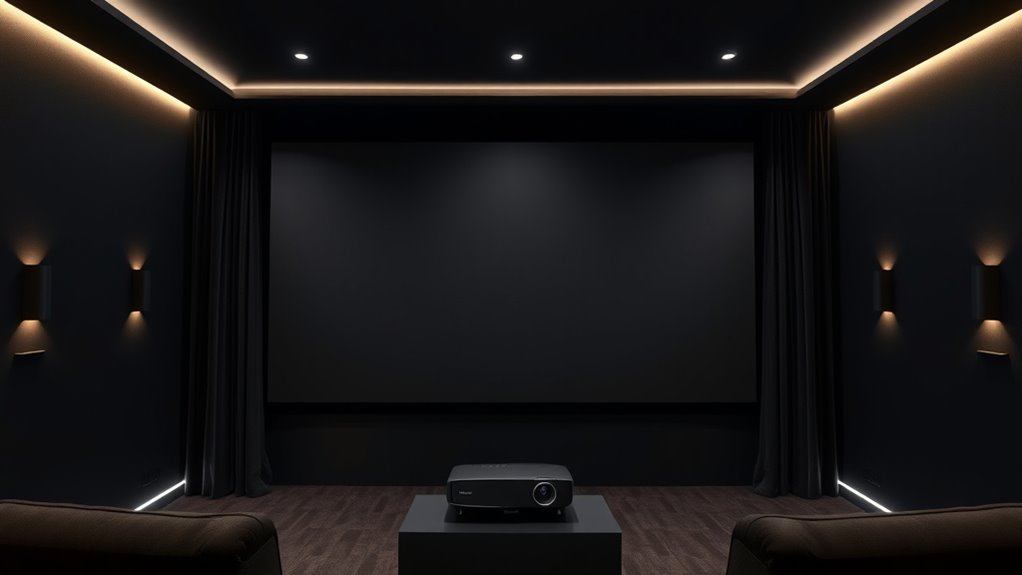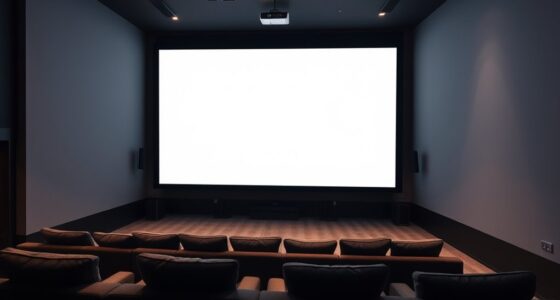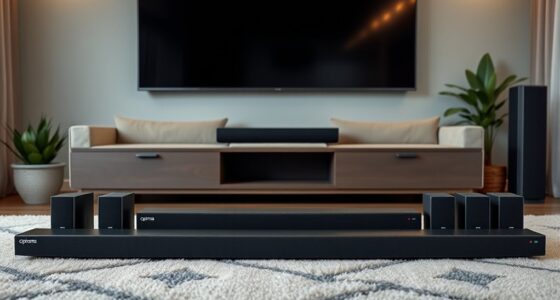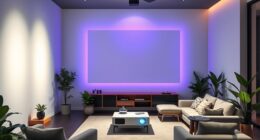If you want the best screen paints for your dedicated theater room in 2025, I recommend options like projector screen paint for a smooth finish, high-definition 4K/8K compatible paints, Lumina Pro aluminum white for bright, contrast-rich images, and high-contrast paints like Smarter Surfaces for vibrant visuals in low light. Each offers easy application, safety, and excellent image quality. Stay with me, and I’ll share all the details to help you choose the perfect one.
Key Takeaways
- Choose high-quality projector screen paints with matte, anti-glare finishes for optimal clarity in 4K and 8K resolutions.
- Prioritize paints with high reflectivity and appropriate gain to enhance brightness and contrast in your theater room.
- Ensure proper surface preparation, including sanding and priming, to maximize adhesion and image sharpness.
- Opt for eco-friendly, low VOC paints that are easy to apply with rollers or sprayers for a DIY-friendly setup.
- Consider specialized high-contrast paints for vibrant images and better black levels in low-light or ambient-lit environments.
Projector Screen Paint, 1 Gallon
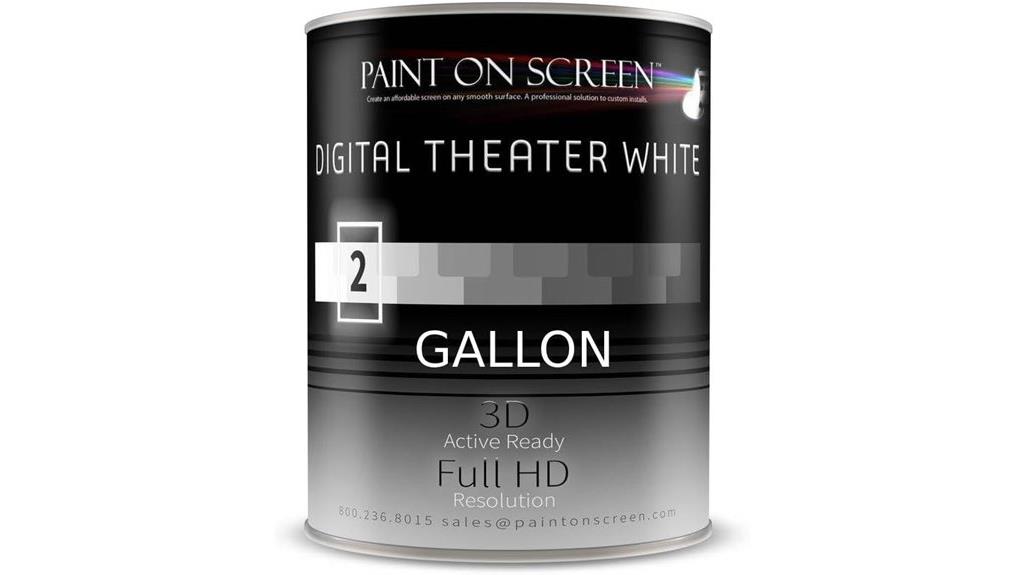
If you’re looking to transform any indoor surface into a high-quality projection screen, the 1-gallon projector screen paint is an excellent choice. It turns walls, ceilings, floors, or even windows into vibrant, sharp projection surfaces. With a matte finish in Digital Theater White, it’s perfect for 1080 HD and 4K UHD clarity. The water-resistant, washable acrylic liquid guarantees durability, while multiple coats improve picture vibrancy and contrast. Just prepare your surface properly—sand, prime, and apply several coats—and wait about 24 hours for curing. This paint offers a cost-effective, customizable way to create a professional home theater experience.
Best For: DIY home theater enthusiasts, gamers, and professionals seeking a customizable, high-quality projection surface indoors.
Pros:
- Transforms any indoor surface into a vibrant, sharp projection screen with high clarity.
- Water-resistant, washable, and durable for long-lasting use.
- Cost-effective alternative to traditional projection screens with customizable sizing and placement.
Cons:
- Requires thorough surface preparation and multiple coats for optimal results.
- Not suitable for outdoor use or environments with high humidity.
- Potential color hue shifts and watery consistency may require projector adjustments for best image quality.
Projector Screen Paint – High Definition, 4K/8K, Ultra White – Quart

For those seeking a high-quality, customizable projection surface, the Projector Screen Paint in Ultra White offers an excellent DIY solution. Available in a quart size, it covers about 40 square feet with two coats, supporting stunning 4K and 8K HD resolutions. The paint’s reflective anti-glare sheen and 1.5 gain boost brightness, contrast, and clarity, making images pop. It’s washable, repairable, non-toxic, and easy to apply with a roller or sprayer. Perfect for home theaters, churches, or outdoor screens, it transforms walls into high-performance screens without the expense of commercial options. Plus, it blends seamlessly with your decor for a sleek, professional look.
Best For: DIY enthusiasts, home theater owners, and anyone seeking an affordable, customizable projection surface with high-definition clarity.
Pros:
- Supports 4K/8K HD resolution with vibrant color, contrast, and clarity
- Easy to apply using roller or sprayer, no professional installation needed
- Washable, repairable, non-toxic, and low VOCs for safe and long-lasting use
Cons:
- May require smoothing and prep to minimize surface imperfections like seams or brush strokes
- Slight gloss or bumpy finish possible, needing additional sanding or coats for perfection
- Coverage per quart is roughly enough for two coats over an 8×5 feet area, potentially requiring multiple cans for larger screens
Projection Screen Painting Lumina Pro Aluminum White
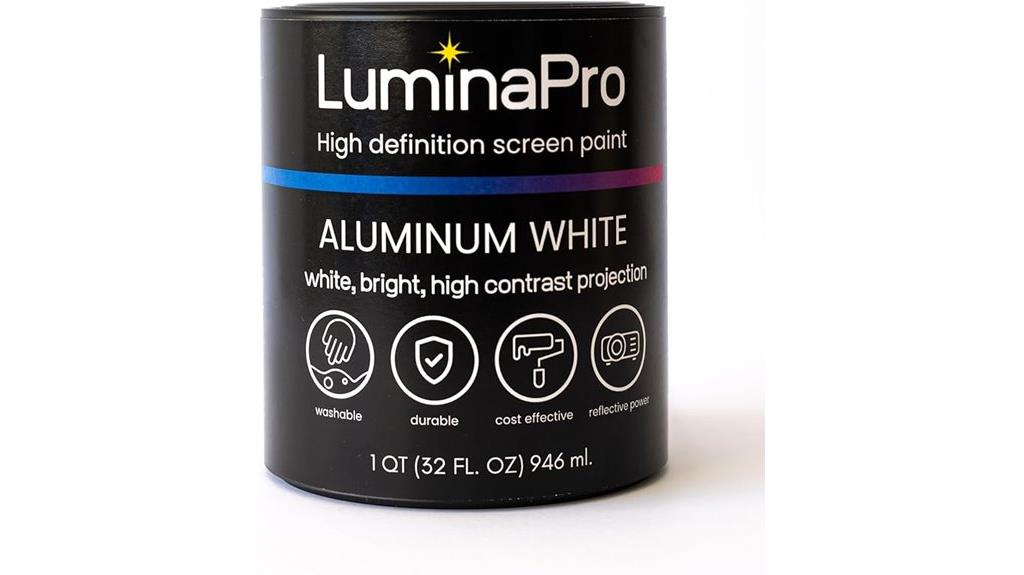
Lumina Pro Aluminum White stands out as an ideal choice for creating high-definition theater screens in home or office spaces, thanks to its advanced ultra-white color formula. This latex acrylic paint enhances contrast, sharpness, and vibrancy, making it perfect for HD and 4K projectors. It’s easy to apply on smooth walls or ceilings, creating a customizable projection surface. The slight grayish hue from its metal content improves reflection and contrast, mimicking cinema screens’ shimmer. With crack resistance, low odor, and water resistance, it’s safe, durable, and suitable for indoor and outdoor use, delivering superior image quality with minimal effort.
Best For: Home and office owners seeking an easy-to-apply, durable projection screen paint that enhances HD and 4K image quality with vibrant contrast and sharpness.
Pros:
- Easy to apply on smooth walls or ceilings without professional skills
- Enhances contrast, vibrancy, and clarity for HD and 4K projectors
- Water-based, low odor, and washable for safe and convenient use
Cons:
- Slight grayish hue may affect color accuracy for some applications
- Requires a smooth surface for optimal results; uneven surfaces can impact image quality
- Limited to indoor and outdoor surfaces with proper preparation, which may require additional priming
Smarter Surfaces Projector Screen Paint for Wall
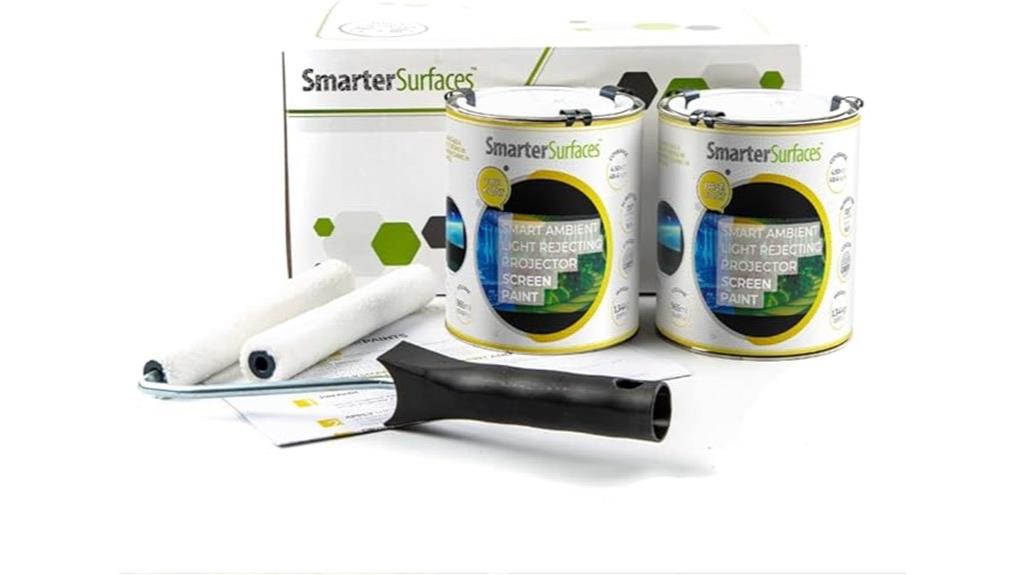
Smarter Surfaces Projector Screen Paint for Wall stands out as an excellent option for those who want a high-quality, seamless projection surface without investing in a traditional screen. It creates a durable, high-performance indoor projection area that blocks ambient light, boosting contrast and image clarity. With a light grey finish, it’s perfect for bright rooms and supports 4K, HD, and interactive projectors. The application is straightforward—just two coats of primer and two coats of paint—and it’s compatible with various surfaces like drywall, wood, and concrete. Certified eco-friendly and backed by a 5-year guarantee, it’s a practical, versatile solution for DIY home theaters.
Best For: DIY home theater enthusiasts and media room owners seeking a high-quality, seamless projection surface that enhances image clarity without the expense of a traditional screen.
Pros:
- Blocks ambient light to improve contrast and image vividness
- Compatible with various surfaces including drywall, wood, and concrete
- Eco-friendly with low VOCs and a 5-year durability guarantee
Cons:
- Requires meticulous application to avoid visible defects after drying
- Some users report incomplete kits or difficulty achieving a perfectly smooth finish with included rollers
- Customer ratings are mixed, indicating variable user experiences
SmarterSurfaces Ultra High Contrast Projector Screen Paint (270 sqft)

If you want to turn any smooth surface into a high-quality projection screen, the SmarterSurfaces Ultra High Contrast Projector Screen Paint is an excellent choice, especially for home theater and gaming setups. This 270 sqft paint enhances black levels and contrast, making images pop even in low-light environments. Its grey matte finish absorbs ambient light, ensuring better clarity and vibrancy for 4K, 8K, and HD projectors. Easy to apply with a roller or sprayer, it’s low-cost and environmentally friendly. Designed for indoor use on various surfaces, it’s perfect for creating a custom, high-performance projection surface that maximizes image quality and contrast.
Best For: Home theater enthusiasts and gamers looking to create a high-contrast, low-cost projection surface on various indoor smooth surfaces.
Pros:
- Enhances black levels and contrast for vivid, vibrant images in low-light environments
- Easy to apply with roller or sprayer on multiple surfaces like drywall, wood, and metal
- Environmentally friendly, low VOC, solvent-free, and safe for indoor use
Cons:
- Requires both base coat and top coat application for optimal results
- May need proper surface preparation to ensure smooth and even finish
- Designed primarily for indoor use; less suitable for outdoor or highly textured surfaces
Factors to Consider When Choosing Screen Paint for a Dedicated Theater
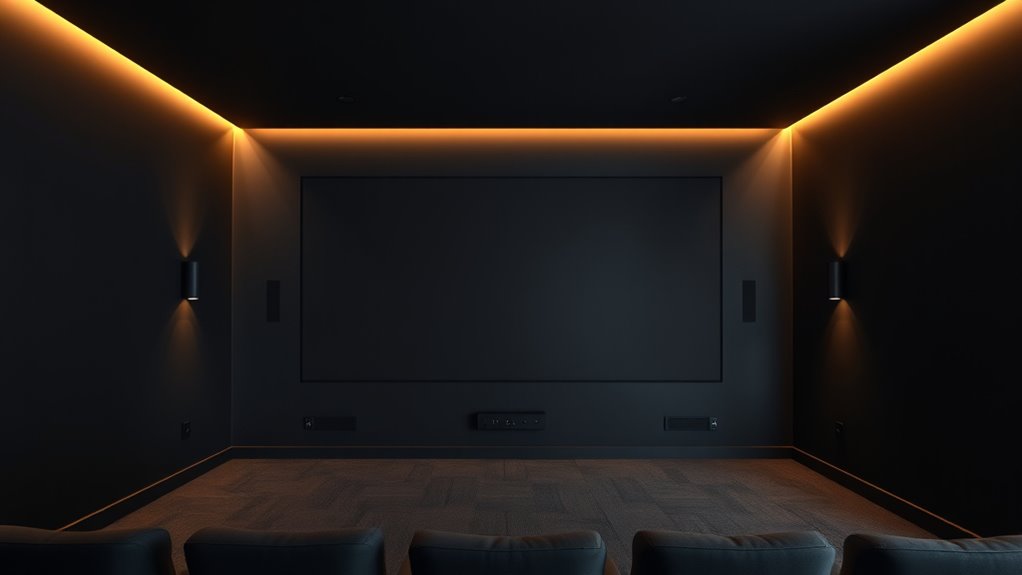
When selecting screen paint for a dedicated theater, I consider factors like brightness, contrast, and resolution compatibility to guarantee the best viewing experience. I also look at surface preparation, ease of application, and whether the paint meets safety standards. These points help me choose a paint that delivers vivid images while fitting my room’s specific needs.
Brightness and Contrast
Have you ever noticed how some theater screens make images pop with richer colors and deeper blacks? That’s the magic of brightness and contrast working together. Higher contrast levels boost the depth and vividness of images, especially in dimly lit rooms. Brightness, measured by gain, reflects how well the screen bounces light back, with values between 0.6 and 1.5 providing clearer images. To maximize contrast, look for paints designed to reject ambient light, preventing washout and keeping images sharp. Keep in mind, your projector’s lumen output also plays a role—high-lumen projectors benefit more from high-contrast paints. Proper surface prep and application are essential to ensure the paint’s reflective qualities truly enhance brightness and contrast, creating a more immersive viewing experience.
Resolution Compatibility
Choosing the right screen paint for your theater starts with verifying it supports your projector’s resolution, whether that’s 1080p, 4K, or 8K. Higher resolution projectors demand a surface that maintains sharpness without blurring or pixelation. Some paints are specially formulated to enhance HD, 4K, or 8K content, delivering sharper details and vibrant colors. Compatibility between the paint’s reflective qualities and your projector’s resolution is vital for optimal image quality. If the paint’s recommended resolution doesn’t match your projector’s output, you might experience diminished clarity or color accuracy. Always verify that the paint’s specifications align with your projector’s resolution to guarantee you get the best possible picture. Matching resolution compatibility is essential for a truly immersive and crisp viewing experience.
Surface Preparation Needs
Proper surface preparation is essential for achieving the best projection quality with your theater screen paint. I recommend sanding the walls to create a smooth, even surface that enhances clarity and minimizes distortion. Removing dust, debris, and grease is vital to prevent imperfections and guarantee good adhesion. Sometimes, multiple coats of primer are needed, especially on textured or uneven walls, to establish a flat, uniform base. Lightly sanding between coats helps eliminate brush strokes and bumps, giving a professional finish. Don’t rush the drying and curing process — giving each layer enough time guarantees maximum adhesion and image sharpness. Taking these steps might seem tedious, but they pay off with a brighter, clearer, and more consistent projection, transforming your space into a true home theater.
Ease of Application
When selecting screen paint for your dedicated theater, ease of application should be a top priority. Look for products with smooth, self-leveling formulas that go on evenly and prevent streaks, saving you time and frustration. Choose paints that can be applied with common tools like rollers or sprayers to make the process straightforward. Opt for options that require minimal surface prep—light sanding or priming—so you can cut down on setup. A thicker consistency helps the paint adhere better, often reducing the need for multiple coats or touch-ups. Finally, check customer reviews for insights into paints praised for simple application and clear instructions. Prioritizing ease of application ensures a smooth, hassle-free painting experience and a flawless screen surface.
Environmental Safety Standards
Ever wonder how to guarantee your theater room stays safe and healthy while enjoying a stunning projection surface? The key is choosing a screen paint that meets strict environmental safety standards. Look for products with certifications indicating low VOC content and non-toxicity, ensuring they emit minimal harmful fumes. It’s crucial to avoid paints containing dangerous chemicals like isocyanates, PFOA, PFOS, or other volatile organic compounds, which can pollute indoor air. Water-based, latex acrylic formulas are a smart choice—they’re eco-friendly, easy to clean, and safe for enclosed spaces. Also, check for eco-labels or certifications that confirm adherence to sustainable manufacturing practices. Prioritizing these standards helps create a healthy, safe environment for you and your family while enjoying your dedicated theater.
Frequently Asked Questions
How Long Does Screen Paint Typically Last Before Needing Reapplication?
Screen paint usually lasts around 5 to 8 years before needing a refresh, depending on usage and maintenance. I recommend inspecting your screen periodically for any fading, scratches, or discoloration. If you notice these issues, it’s a good idea to reapply a fresh coat to keep your picture vibrant and sharp. Proper cleaning and avoiding harsh chemicals can extend the life of your screen paint considerably.
Can Screen Paint Be Used on Textured or Uneven Wall Surfaces?
Absolutely, screen paint can be used on textured or uneven walls, but results vary. For example, I once helped a client with a popcorn ceiling, and we smoothed it out as much as possible before applying the paint. If you can’t smooth the surface, opt for a high-quality, flexible screen paint designed to hide imperfections, and consider a primer to help achieve a more uniform, vibrant projection surface.
Is There a Significant Color Difference Between Matte and Glossy Finishes?
Yes, there’s a noticeable difference between matte and glossy finishes. Matte paints absorb light, reducing glare and providing a softer image, which is ideal for home theater screens. Glossy finishes reflect light, creating a brighter, more vibrant look but can cause unwanted reflections and glare that distract from your viewing experience. I recommend matte finishes for a cinema-like effect, ensuring clear, immersive visuals without glare interruptions.
How Does Ambient Light Affect the Performance of Different Screen Paints?
Ambient light can considerably impact how different screen paints perform. I’ve found that matte finishes handle ambient light better because they diffuse light and reduce glare, making images clearer even in bright rooms. Glossy paints, on the other hand, tend to reflect ambient light, which can wash out the picture and diminish contrast. So, if your room isn’t perfectly dark, matte paints are generally a smarter choice for ideal viewing.
Are There Eco-Friendly or Low-Voc Options Available for Projector Screen Paints?
Think of eco-friendly projector screen paints as the green gardens of your home theater. Yes, they exist! Many low-VOC paints are available that are safe for your family and the environment. I recommend looking for products labeled as low or zero VOC, which maintain high performance without harming the planet. These options let you enjoy a cinematic experience while keeping your space healthy and sustainable.
Conclusion
Choosing the right screen paint feels like finding the perfect canvas for my own cinematic dreams. When I see that smooth, vibrant surface come to life under dim lights, it’s like a secret waiting to be revealed—a cozy theater just for me. I realize that selecting the right paint isn’t just about color or brightness; it’s about creating a space where every movie night feels like stepping into another world.
